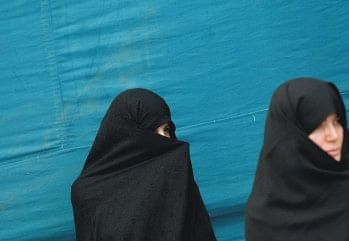Does Islam require a Muslim woman to veil her face?

IMAGE: AFP
RECENTLY, there has been a spate of letters in the letters to the editor section of the DS on the Belgian ban on burqa. From mufti to barrister, readers joined in to register their support for the burqa on various grounds.
Amidst the entire hullabaloo, nobody asked a basic question: Does Islam require a Muslim woman to veil her face?
First, let us make clear the distinction between the hijab and the burqa or niqab.
Hijab allows a Muslim woman to cover her hair, neck and bosom, but leave her face open. It is strikingly similar to the dress worn by the Christian nuns. It has been adopted in Muslim majority countries like Malaysia, Indonesia and large parts of the Middle East. It faces no ban in general in the West, except that in France students in public schools cannot wear it as it is thought to be a religious symbol.
Burqa, or niqab, in addition covers the face and thereby hides the identity of the person. Burqa provides a mesh in front of the eyes, while niqab allows a slit for seeing through.
In the current worldwide concern about security, some countries think that burqa/niqab is a threat as a terrorist can hide behind it and carry out destructive activities.
Quranic prescription of dress for Muslim women is contained basically in two verses: 33:59 and 24:31.
In verse 33: 59, Allah says (all translations by A. Yusuf Ali):
"O prophet! Tell thy wives and daughters and the believing women that they should cast their outer garments over their persons (when abroad): that is most convenient that they should be known (as such) and not molested: and Allah is Oft-Forgiving, Most Merciful."
The immediate reason for this revelation was to distinguish the free believing women from the female slaves so that bad elements would not molest the former.
Yusuf Ali in his commentary on the above verse states: "The object was not to restrict the liberty of women, but to protect them from harm and molestation under the conditions then existing in Medina." He further states: "This rule was not absolute: if for any reason it could not be observed, then 'Allah is Oft-Forgiving, Most Merciful.' "
The critical Arabic word in the original verse is jilbab, which has been translated by Yusuf Ali as an outer garment; a long gown covering the whole body; or a cloak covering the neck and bosom.
Whatever may be the interpretation of the word jilbab, it is quite obvious that the requirements were quite strict.
In verse 24:31, Allah lays down:
"And say to the believing women that they should lower their gaze and guard their modesty; that they should not display their beauty and ornaments except what (must ordinarily) appear thereof; that they should draw their veils over their bosoms and not display their beauty except to their husbands."
It is seen clearly from the above verse that (1) Allah does not specifically ask for covering of the hair or face, (2) allows display of certain parts of beauty and ornaments (that must ordinarily be exposed) and (3) specifically calls for covering of the bosoms.
Moreover, Allah has not set any details of what could be seen or not be seen of the women, possibly to allow space for different cultures, climates and environments that would ultimately come under the umbrella of Islam.
Since verse 33:59 is much stricter compared to verse 24:31, it is important to know their chronological order in the revelation.
Sura 33 (The Clans) was revealed in 5 A.H.
As regards Sura 24 (Light), there is some controversy about its exact period of revelation. However, Maududi conclusively shows in his Introduction to Suras that the majority of Islamic scholars accept that it was revealed in the latter half of 6 A.H., i.e. several months after Sura 33.
Maududi thinks that verse 24:31 is complementary to verse 33:59. This is open to question. If someone has already covered herself up as required in verse 33:59, with a loose outer garment or a cloak covering neck and bosom, then what need is there for covering of the bosoms with a veil or sheet as required in verse 24: 31?
The more plausible explanation would be that the Beneficent had reduced the requirements in the latter verse. This is akin to the case of drinking, where Muslims were first asked not to come to mosque while in intoxicated state (verse 4:43), and the ban on drinking alcohol came later.
If the move from a lenient to a stricter regulation is willingly accepted, why should not one accept a move from a stricter regulation to a lenient one? After all, it is the prerogative of the Almighty as to what to relax and what to tighten. But our orthodox maulanas have a propensity to only tighten the screw.
During Hajj, it is forbidden for women performing Hajj to cover their faces: "As for a woman pilgrim, she is forbidden to use perfumed clothes, a veil that covers the face, and gloves" (Fiqh-us-Sunnah). If covering the face were a necessity for modesty, Hajj would have been the right time to enforce it with full rigidity.
In the well-known Hadith (Abu Daoud) narrated by Hazrat Aisha, the Prophet (pbuh) tells his sister-in-law Asma: "When a woman begins to menstruate, nothing should be seen of her except this and this," and he pointed to his face and palms.
Sheikh Muhammad Sayyid Tantawy, former Grand Mufti (1986-1996) of Egypt and Grand Sheikh of the prestigious Al-Azhar University, was of the opinion that the face-veil was a cultural tradition and had nothing to do with Islam. He himself removed the face-veil from a student who was not willing to do so, and told her not to wear it again.
That the face-veil is a cultural tradition is borne out by the fact it was mentioned to have been worn by Persian and Arabian women as early as the 1st and 3rd centuries, i.e. it existed several centuries before the revelations came to Prophet Muhammad (pbuh).
Veiling the face robs a woman of her identity and dehumanises her, and is not required either by Quranic injunctions or traditions of the Prophet (pbuh). Those who still choose to do so are either showing that they are religious or doing it under peer pressure.
Those who recommend it as an antidote to eve-teasing etc. should in fact remind men of Allah's injunction to lower their (men's) gaze and guard their modesty (24:30). Modesty has not been enjoined only on women.
I believe that a properly worn sari serves the purpose of Islamic dress for women.
Religion is too important to be left (for interpretation) to those who have taken it up as their profession. Most religious professionals, because of their rote learning and lack of knowledge of science and arts, cannot think outside the box and lack a spirit of enquiry. They tend to operate on the principle "the stricter, the better," particularly on women's issues. One Saudi cleric recently came up with the suggestion that women should reveal only one eye in public!
Modern Muslims should study religion and come to their own conclusion on important issues.

 For all latest news, follow The Daily Star's Google News channel.
For all latest news, follow The Daily Star's Google News channel. 



Comments